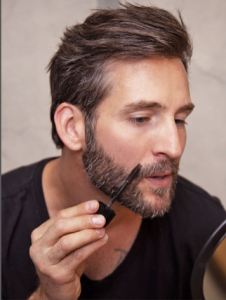Anyone with a beard, or who has grown one before, can tell you that beards are full of surprises. And we’re not just talking about yesterday’s crumbs hidden in the curtain of whiskers. Growing a beard means discovering things about your facial hair that you might never have realized before like it’s way curlier than the hair on our head, it grows slower in some places than others, or that keeping your neckline clean requires daily shaving. And often, no matter how old you are, one of those surprises is grey hair.

Many guys notice grey hairs popping up in their beards before they start seeing them on their heads. It doesn’t even have to be grey either—the funny thing about beards is that often the colour of your facial hair doesn’t match the colour of the hair on top of your head, like when your beard appears more reddish.
Some guys might not care so much, but many do—and if you’re one of those men who do, beard dye is your best friend. Beard dyes help camouflage grey or other colour differences and subtly blends the colours to look more uniform. Bonus: they can also help patchy or thin beards look fuller and more robust.
Here is How to Dye Your Beard at Home
Just because you’ve decided to dye your beard doesn’t mean you should run out and grab any old box of hair dye. The cardinal rule of home beard dyeing is to use colour made for your beard. There are a few reasons for this. First, the skin on your face is more sensitive than the skin on your scalp. Box dyes for your head could be too harsh and irritate the facial skin underneath your whiskers. Second, box dyes for your head are very opaque. Beard dyes, on the other hand, are thinner and semi-permanent, which means they can camouflage greys without turning your beard one uniform colour (which ends up looking fake). But facial hair also tends to be more coarse than the hair on your head, which is why beard dyes are powerful enough to penetrate that hair but completely wreck it.
The good news is that home beard dyes are easy to use. Some come pre-mixed, while others require you to mix yourself. Whichever you choose, the most important thing you can do is follow the directions. Leave it on for the amount of time the package says and no more. And if you get dye on your skin, remove it with rubbing alcohol followed by soap and water—but wait until after you’ve washed out the colour, of course. And if you’re still nervous about taking matters into your own hands, you can always make an appointment with a professional colourist to get their advice.